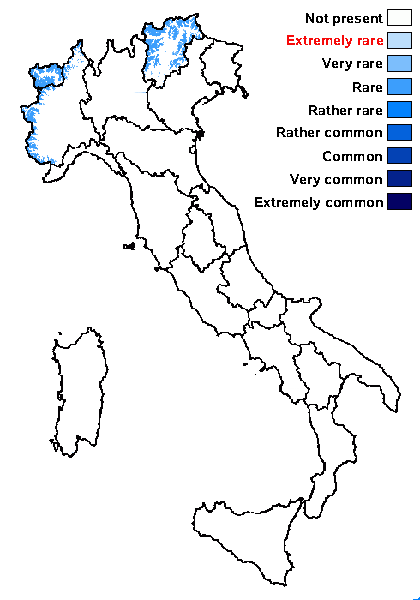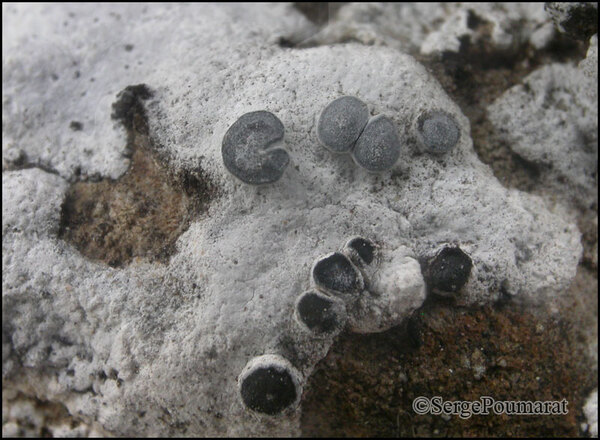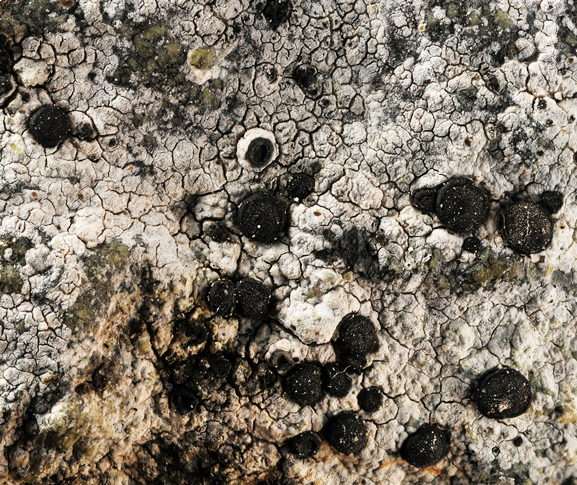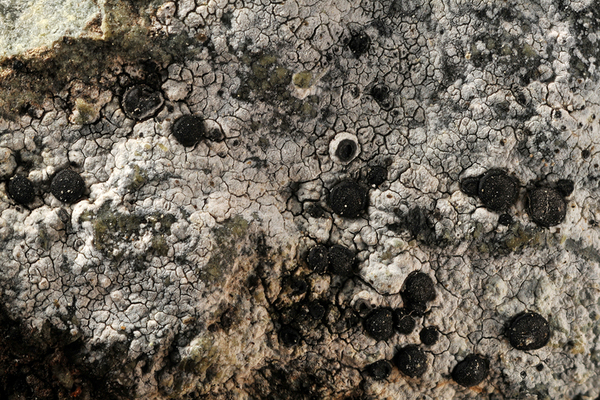Porpidia trullisata (Kremp.) Körb.
Syst. Lich. Germ.: 221, 1855. Basionym: Diplotomma trullisatum Kremp. - Flora, 36: 442-444, 1853.
Synonyms: Lecidea euspeirea Nyl.; Lecidea speirea f. trullisata (Kremp.) Stein; Lecidea speirea var. trullisata (Kremp.) Arnold; Lecidea trullisata (Kremp.) Anzi
Distribution: N - TAA (Nascimbene & al. 2022), Piem (Isocrono & al. 2004), VA (Piervittori & Isocrono 1999).
Description: Thallus crustose, episubstratic, to 2.5 mm thick, chalky white to pale grey, continuous to rimose-areolate. Medulla white, I- or I+ pale blue. Apothecia lecideine, black, 0.5-2.5(-3.5) mm across, at first immersed, but soon broadly sessile, with a strongly bluish-pruinose, flat to strongly convex disc and a less pruinose to epruinose, initially evident but soon excluded proper margin. Proper exciple thin, black-brown throughout, K-, continuous with hypothecium; epithecium brownish green to green-black, 15-20 µm high; hymenium very pale yellowish green to colourless, 80-120 µm high; paraphyses strongly coherent, branched and anastomosing in upper part, 1.5-2.2 µm thick at mid-level, the apical cell to 3.5 µm wide; hypothecium brown-black. Asci 8-spored, elongate-clavate, with a thin, outer amyloid layer and a thickened tholus penetrated by a pore, the sides of which are strongly amyloid, Porpidia-type. Ascospores 1-celled, hyaline, ellipsoid 10-16(-21) x 5-9(-11) µm. Photobiont chlorococcoid. Spot tests: thallus K-, C-, KC-, P-; medulla sometimes K+ faintly yellow, P+ faintly orange-yellow. Chemistry: without lichen substances, or medulla with stictic acid (usually in low amounts or traces).Note: on north-facing, steeply inclined surfaces of weakly calciferous rocks with optimum above treeline, reaching the nival belt; apparently restricted to the Alps in Italy.
Growth form: Crustose
Substrata: rocks
Photobiont: green algae other than Trentepohlia
Reproductive strategy: mainly sexual
Commonnes-rarity: (info)
Alpine belt: rare
Subalpine belt: very rare
Oromediterranean belt: absent
Montane belt: absent
Submediterranean belt: absent
Padanian area: absent
Humid submediterranean belt: absent
Humid mediterranean belt: absent
Dry mediterranean belt: absent

Predictive model
Herbarium samples
Growth form: Crustose
Substrata: rocks
Photobiont: green algae other than Trentepohlia
Reproductive strategy: mainly sexual
Commonnes-rarity: (info)
Alpine belt: rare
Subalpine belt: very rare
Oromediterranean belt: absent
Montane belt: absent
Submediterranean belt: absent
Padanian area: absent
Humid submediterranean belt: absent
Humid mediterranean belt: absent
Dry mediterranean belt: absent

Predictive model
| Herbarium samples |
 INDEX FUNGORUM
INDEX FUNGORUM
 GBIF
GBIF
 DOLICHENS
DOLICHENS




